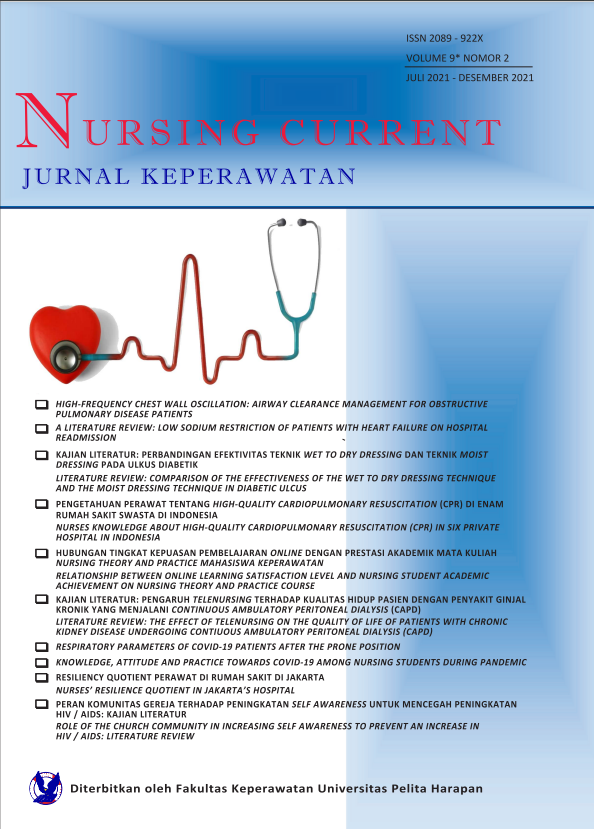A LITERATURE REVIEW: LOW SODIUM RESTRICTION OF PATIENTS WITH HEART FAILURE ON HOSPITAL READMISSION
DOI:
https://doi.org/10.19166/nc.v9i2.4917Kata Kunci:
Heart Failure, Readmission, Sodium RestrictionAbstrak
Sodium restriction effect on hospital readmission in patients with heart failure (HF) has been questioned for decades. Readmission related to low sodium intake recommendations should be changed as well as mortality. A literature review is needed to summarize the effect of low sodium, especially on readmission and mortality. This literature review aimed to summarize the prevalence of hospital readmission and mortality regarding low sodium intake in patients with HF. The searching process involved four databases; MEDLINE, Embase, EBSCO Health, Cochrane was explored for experimental studies of sodium restriction. Of 77 screened citations from 2000 to 2019 invested in patients with HF, four studies were included. Four studies from four databases were included and explained and it was found that hospital readmission was the outcome of implementing sodium restriction in patients with HF. Low sodium restriction (800 mg - 1800 mg/day) results in higher hospital readmission. Moreover, 1800 mg/day of sodium was followed by higher mortality and higher sudden death in patients with HF. Low sodium restriction did not lower hospital readmission as well as mortality of patients with HF. This article provides the reason, effect, and amount of sodium restriction in patients with HF. The recommendation from this literature review is low sodium restriction has no beneficial effect on readmission and mortality in HF conditions.
Referensi
Aliti, G. B., Rabelo, E. R., Clausell, N., Rohde, L. E., Biolo, A., & Beck-da-Silva, L. (2013). Aggressive fluid and sodium restriction in acute decompensated heart failure: a randomized clinical trial. JAMA Internal Medicine, 173(12), 1058”1064. https://doi.org/10.1001/jamainternmed.2013.552
Chatterjee, K. (2005). Neurohormonal activation in congestive heart failure and the role of vasopressin. American Journal of Cardiology, 95(9A), 8B-13B. https://doi.org/10.1016/j.amjcard.2005.03.003
Cohen, H. W., Hailpern, S. M., Fang, J., & Alderman, M. H. (2006). Sodium intake and mortality in the NHANES II follow-up study. American Journal of Medicine, 119(3), 275 e277-214. https://doi.org/10.1016/j.amjmed.2005.10.042
d’Almeida, K. S., Rabelo-Silva, E. R., Souza, G. C., Trojahn, M. M., Barilli, S. L., Mansson, J. V., Biolo, A., Rohde, L. E., Clausell, N., & Beck-da-Silva, L. (2014). Effect of fluid and dietary sodium restriction in the management of patients with heart failure and preserved ejection fraction: study protocol for a randomized controlled trial. Trials, 15(1), 1-6. https://doi.org/10.1186/1745-6215-15-347
Groenewegen, A., Rutten, F. H., Mosterd, A., & Hoes, A. W. (2020). Epidemiology of heart failure. European Journal of Heart Failure, 22(8), 1342-1356. https://doi.org/10.1002/ejhf.1858
Gupta, D., Georgiopoulou, V. V., Kalogeropoulos, A. P., Dunbar, S. B., Reilly, C. M., Sands, J. M., Fonarow, G. C., Jessup, M., Gheorghiade, M., Yancy, C., & Butler, J. (2012). Dietary sodium intake in heart failure. Circulation, 126(4), 479-485. https://doi.org/10.1161/CIRCULATIONAHA.111.062430
Hartupee, J., & Mann, D. L. (2017). Neurohormonal activation in heart failure with reduced ejection fraction. Nature Reviews: Cardiology, 14(1), 30-38. https://doi.org/10.1038/nrcardio.2016.163
Kalogeropoulos, A. P., Georgiopoulou, V. V., Murphy, R. A., Newman, A. B., Bauer, D. C., Harris, T. B., Yang, Z., Applegate, W. B., & Kritchevsky, S. B. (2015). Dietary sodium content, mortality, and risk for cardiovascular events in older adults: the Health, Aging, and Body Composition (Health ABC) Study. JAMA Intern Med, 175(3), 410-419. https://doi.org/10.1001/jamainternmed.2014.6278
Lippi, G., & Sanchis-Gomar, F. (2020). Global epidemiology and future trends of heart failure. AME Medical Journal, 5, 15-15. https://doi.org/10.21037/amj.2020.03.03
Lund, L. H., & Savarese, G. (2017). Global Public Health Burden of Heart Failure. Cardiac Failure Review, 3(1), 7-11. https://doi.org/10.15420/cfr.2016:25:2
Patel, Y., & Joseph, J. (2020). Sodium Intake and Heart Failure. International Journal of Molecular Sciences, 21(24), 1-12. https://doi.org/10.3390/ijms21249474
Paterna, S., Fasullo, S., Parrinello, G., Cannizzaro, S., Basile, I., Vitrano, G., Terrazzino, G., Maringhini, G., Ganci, F., Scalzo, S., & et al. (2011). Short-term effects of hypertonic saline solution in acute heart failure and long-term effects of a moderate sodium restriction in patients with compensated heart failure with New York Heart Association class III (Class C) (SMAC-HF Study). The American Journal of the Medical Sciences, 342(1), 27”37. https://doi.org/10.1097/MAJ.0b013e31820f10ad
Paterna, S., Gaspare, P., Fasullo, S., Sarullo, F. M., & Di Pasquale, P. (2008). Normalsodium diet compared with low-sodium diet in compensated congestive heart failure: Is sodium an old enemy or a new friend? Clinical Science, 114(3), 221”230. https://doi.org/10.1042/CS20070193
Paterna, S., Parrinello, G., Cannizzaro, S., Fasullo, S., Torres, D., Sarullo, F. M., & Di Pasquale, P. (2009). Medium term effects of different dosage of diuretic, sodium, and fluid administration on neurohormonal and clinical outcome in patients with recently compensated heart failure. The American Journal of Cardiology, 103(1), 93”102. https://doi.org/10.1016/j.amjcard.2008.08.043
Ponikowski, P., Voors, A. A., Anker, S. D., Bueno, H., Cleland, J. G., Coats, A. J., Falk, V., Gonza´lez-Juanatey, J. R., & van der Meer, P. (2016). 2016 ESC Guidelines for the diagnosis and treatment of acute and chronic heart failure: The Task Force for the diagnosis and treatment of acute and chronic heart failure of the European Society of Cardiology (ESC). Developed with the special contribution of the Heart Failure Association (HFA) of the ESC. European Heart Journal, 37(27), 2129-2200. https://doi.org/10.1093/eurheartj/ehw128
Unduhan
Diterbitkan
Cara Mengutip
Terbitan
Bagian
Lisensi
Authors who publish with this journal agree to the following terms:
1) Authors retain copyright and grant the journal right of first publication with the work simultaneously licensed under a Creative Commons Attribution License (CC-BY-SA 4.0) that allows others to share the work with an acknowledgement of the work's authorship and initial publication in this journal.
2) Authors are able to enter into separate, additional contractual arrangements for the non-exclusive distribution of the journal's published version of the work (e.g., post it to an institutional repository or publish it in a book), with an acknowledgement of its initial publication in this journal.
3) Authors are permitted and encouraged to post their work online (e.g., in institutional repositories or on their website). The final published PDF should be used and bibliographic details that credit the publication in this journal should be included.

This work is licensed under a Creative Commons Attribution-ShareAlike 4.0 International License.






